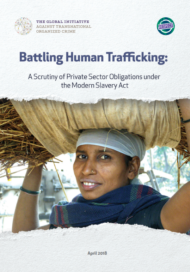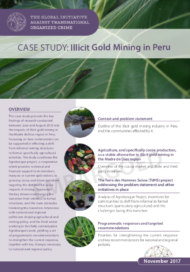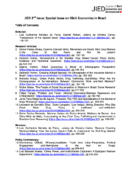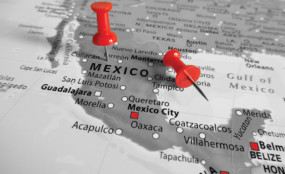The IOM’s recent Remediation Guidelines for Victims of Human Trafficking in Mineral Supply Chains should encourage business to both prevent and remedy human-rights abuses in their supply chains.
In May 2018, the UN migration agency, the International Organization for Migration (IOM), published its Remediation Guidelines for Victims of Human Trafficking in Mineral Supply Chains. Global Initiative senior analysts Livia Wagner and Marcena Hunter contributed knowledge and gave inputs into the development of the document.
Artisanal and small-scale mining (ASM) is a complex global phenomenon, with supply chains often involving an array of actors working in multiple sites, and products and workers crossing international borders. This inherent complexity is compounded by the disparate ways in which the ASM sector impacts communities and society. While ASM may provide a livelihood for millions worldwide, playing an important role in poverty alleviation and economic development, it is also linked to devastating impacts on the environment, health and human rights. The informal and unregulated nature of the sector also makes it vulnerable to criminal infiltration and illicit financial flows. These complex dynamics have been investigated and analyzed by the Global Initiative in Latin America, Africa and Asia.
The IOM guidelines were published against this backdrop – a context in which multinational corporations that source minerals as inputs are facing increasing pressure to ensure human and labour rights are respected in mineral supply chains. In particular, reports of human trafficking for sexual exploitation in mining areas, forced labour and worst forms of child labour have raised serious concerns for downstream companies about the social cost of doing business with the ASM sector. As documented by RESPECT – a joint initiative of the Global Initiative, Babson College’s Initiative on Human Trafficking and Modern Slavery and the IOM – the private sector is being held to account for human-rights violations in supply chains in an unprecedented manner.
However, while corporations would clearly not want to be associated with human-rights abuses in their mineral purchasing practices, moves to eradicate ASM products from their supply chains could backfire, with a detrimental impact on development, and precipitate the sector further into the clutches of illicit actors.
Prevention and cure both needed
Industry action on forward-looking responsibility has advanced a great deal in recent years, with significant investments made in due-diligence programmes. The OECD’s Due Diligence Guidance for Responsible Supply Chains of Minerals from Conflict-Affected and High-Risk Areas has been especially instrumental here. The document’s recommendations help private actors to source mineral inputs from ASM supply chains while reducing the risk of contributing (albeit indirectly and unintentionally) to human-rights violations. However, such industry-specific guidelines tend to focus on human and labour rights in general, but do not address the specific risk of human trafficking for labour and sexual exploitation. The informal mining sector is particularly vulnerable to these forms of violations.
Also, the backward-looking responsibility of businesses to address human-rights abuses when they do occur has not received enough attention. As articulated in the UN Guiding Principles on Business and Human Rights (UNGPs), businesses not only have a responsibility to prevent human-rights abuses, but also to provide remedies to victims where harm has occurred. Specifically, although there is evidence of human trafficking in certain ASM supply chains, and companies recognize their responsibility to provide remedies, current industry responses have tended to lack targeted action plans to provide protection and remediation to victims of human trafficking.
Hence, to support businesses that are committed to fulfilling their responsibilities under the UNGPs, the IOM developed its remediation guidelines for downstream companies and their business partners. The guidelines go beyond due diligence, providing concrete, operational guidance on how to take incidents forward when victims have been identified in the supply chain. The guidelines are not prescriptive, but rather designed to serve as guidance for entities on how to implement remediation processes. Their aim is to highlight best practices for companies to consider and replicate in an effort to advance remediation in their own operations and supply chains.
At their heart are remediation processes that downstream companies can follow when a victim has suffered harm linked to the company’s operations, products or services. The guidelines outline the roles and responsibilities of key actors, and appropriate action to be taken. They also illustrate the options that actors have at various stages in the process, helping them identify the different elements that need to be taken into account when making decisions. Ultimately, the operational remediation process helps downstream companies and their business partners identify the steps to follow, the stakeholders to engage with and the various factors to consider, so that victims are provided with an effective remedy.
While these guidelines focus on human trafficking, much of the content is also applicable to other exploitative practices, including the worst forms of child labour, forced labour, debt bondage, commercial sexual exploitation and contemporary forms of slavery. Collectively often referred to as ‘modern slavery’, these terms have various legal definitions but often share common elements, essentially describing situations of exploitation from which a victim cannot easily walk away. The process and principles below could also be applied to other sectors, such as the garment industry, agriculture or construction.
Although responding to criminal threats in the ASM sector is a complex and daunting task, it does not exculpate corporations from their responsibility to not only prevent human-rights abuses, but to also provide fitting protection and remedies when they do occur. The IOM guidance is therefore a valuable and much needed tool to assist corporations in taking responsibility for their supply chains by helping them look backwards, as well as forward.
Las directrices de la OIM para la reparación a las víctimas de la trata de personas
Las Directrices publicadas recientemente por la OIM para la Reparación a las Víctimas de la Trata en las Cadenas de Suministro de la Industria Minera alientan a las empresas tanto a prevenir como a reparar cualquier abuso de los derechos humanos en sus cadenas de suministro.
En mayo de 2018, la agencia para las migraciones de la ONU, la Organización Internacional para las Migraciones (OIM), publicó las Directrices para la Reparación a las Víctimas de la Trata en las Cadenas de Suministro de la Industria Minera. Livia Wagner y Marcena Hunter, analistas senior de la Iniciativa Global, contribuyeron con sus conocimientos en la creación del documento.
La minería artesanal y en pequeña escala (MAPE) es un fenómeno mundial complejo en el que las cadenas de suministro suelen involucrar a una serie de actores que operan en varios sitios y en donde productos y trabajadores cruzan fronteras internacionales. Esta complejidad inherente al sector se ve agravada por las diversas maneras en las que la MAPE impacta en las comunidades y la sociedad. Si bien la MAPE puede significar una forma de sustento para millones de personas en todo el mundo y tener un rol importante en el alivio de la pobreza y el desarrollo económico, también conlleva efectos devastadores sobre el medio ambiente, la salud y los derechos humanos. La naturaleza informal y no regulada del sector también lo hace vulnerable a la infiltración criminal y a flujos financieros ilícitos. La Iniciativa Global investigó y analizó estas dinámicas complejas en América Latina, Africa y Asia.
Los lineamientos de la OIM fueron publicados en un contexto en el que las empresas multinacionales que se abastecen de minerales se encuentran frente a una creciente presión de garantizar el respeto a los derechos humanos y laborales en sus cadenas de suministro. Los informes sobre situaciones de trata de personas para explotación sexual, trabajo forzado y las peores formas de trabajo infantil en zonas mineras han despertado serias preocupaciones en empresas comercializadoras y distribuidoras sobre los costos sociales de hacer negocios con el sector de la MAPE. Tal y como fue documentado por RESPECT – un proyecto conjunto entre la Iniciativa Global, la Iniciativa contra la Trata de Personas y la Esclavitud Moderna del Babson College y la OIM – el sector privado está obligado a rendir cuentas de las violaciones a los derechos humanos en las cadenas de suministros de un modo sin precedentes.
Sin embargo, a pesar de que las empresas claramente no querrían ser asociados con situaciones de abusos de los derechos humanos en sus procesos de compra de minerales, las acciones para erradicar productos originarios de la MPAE de sus cadenas de suministro podrían ser contraproducentes, tener un impacto perjudicial sobre el desarrollo y precipitar el sector aún más a las manos de actores ilícitos.
Se debe prevenir y curar
En los últimos años, la industria ha avanzado significativamente en la toma de responsabilidades en materia de prevención, y se han hecho grandes inversiones en programas de diligencia debida. Especialmente instrumentales aquí han sido las Directrices de la OCDE sobre Diligencia Debida para Cadenas de Suministro Responsables en el Sector Minero provenientes de Zonas de Conflicto y de Alto Riesgo. Las recomendaciones que ofrece el documento ayudan a los actores privados a abastecerse de minerales de la MAPE reduciendo el riesgo de contribuir (aunque indirecta e involuntariamente) a que se comentan violaciones a los derechos humanos. No obstante, estas directrices orientadas específicamente a la industria tienden a enfocarse sobre los derechos humanos y laborales en general, sin abordar los riesgos específicos de que surjan situaciones de explotación sexual y laboral, a las cuales el este sector es particularmente vulnerable.
Además, no se ha puesto suficiente atención sobre la responsabilidad de las empresas de reparar las violaciones a los derechos humanos que se hayan cometido. Como se articula en los Principios Rectores de la ONU sobre Empresas y Derechos Humanos, las empresas no solo tienen la responsabilidad de prevenir los abusos de los derechos humanos, sino también de ofrecer reparación a las víctimas cuando el daño haya ocurrido. Si bien hay pruebas de la existencia de la trata de personas en ciertas cadenas de suministro de la MAPE y las empresas admiten su responsabilidad de brindar reparación a las víctimas, las respuestas actuales de la industria tienden a carecer de planes de acción específicos en materia de protección y reparación.
Por tanto, con el fin de apoyar a las empresas que están comprometidas en cumplir con sus responsabilidades de acuerdo a los Principios Rectores de la ONU, la OIM desarrolló una serie de directrices para la reparación de daños dirigidas a empresas de comercialización y distribución y a sus socios comerciales. Las directrices van más allá de la diligencia debida y ofrecen una guía concreta y operativa sobre cómo lidiar con los incidentes cuando se han identificado víctimas en la cadena de suministro. Las directrices no son normativas, sino que fueron diseñadas para servir como una guía para que las organizaciones puedan implementar procesos de reparación. Su objetivo es resaltar las mejores prácticas para que las organizaciones privadas contemplen y repliquen en miras a poner en marcha los procesos de reparación en sus propias operaciones y cadenas de suministro.
En el centro están los procesos de reparación que las empresas comercializadoras y distribuidoras pueden seguir cuando una víctima ha sufrido algún daño vinculado a las operaciones, productos o servicios de la empresa. Las directrices delinean los roles y responsabilidades de los principales actores y las medidas adecuadas que deben tomarse. También ilustran las alternativas con las que los actores cuentan en varias etapas del proceso, ayudándolos a identificar los diferentes elementos que necesitan considerarse al momento de tomar una decisión. Por último, el proceso de reparación operativo ayuda a estas empresas y a sus socios comerciales a establecer los pases a seguir, las partes interesadas con las que interactuar y los varios factores a considerar a los efectos de que las víctimas reciban una reparación efectiva.
Si bien estas directrices ponen el foco en la trata de personas, gran parte del contenido puede también aplicarse a otras prácticas explotadoras, incluyendo las peores formas de trabajo infantil, el trabajo forzado, la esclavitud por deudas, la explotación sexual con fines comerciales y otras formas de esclavitud moderna. Estos delitos, a los que se los suele englobar bajo el término “esclavitud moderna”, tienen varias definiciones legales pero suelen compartir elementos comunes que, esencialmente, describen situaciones de explotación de las cuales la víctima no puede escapar fácilmente. Estos procesos y principios también pueden aplicarse a otros sectores, como la industria textil, la agricultura y la construcción.
A pesar de la ardua y compleja tarea que implica responder a las amenazas criminales en el sector de la MAPE, esto no exculpa a las empresas de su responsabilidad no sólo de prevenir los abusos de los derechos humanos, sino también de brindar protección y reparación cuando se hayan cometido. Las directrices de la OIM son una herramienta valiosa y muy necesaria para asistir a las empresas en la toma de responsabilidad de sus cadenas de suministro ayudándolas a prevenir y a reparar.



